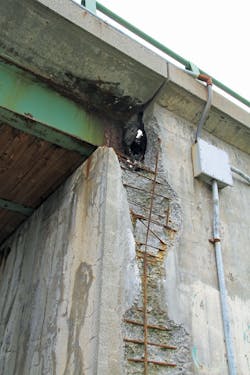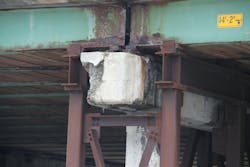Size doesn’t matter
The first state to declare its independence, on May 4, 1776, and the last to ratify the U.S. Constitution, on May 29, 1790, Rhode Island has, it seems, always existed in a state of extremis.
And while it is the smallest state in total area—clocking in at only just over 1,200 sq miles—Rhode Island is second in population density (behind only New Jersey) and one-sixth of its total area is comprised of water. Limited in geographic scope though it may be, Rhode Island’s troubles are many.
For openers, according to Roads & Bridges’ 2015 Bridge Inventory, as aggregated from information provided by the Federal Highway Administration (FHWA), 56% of the state’s bridges are either structurally deficient or functionally obsolete—the worst percentage of any state in the U.S. and second only to the District of Columbia, which sits at 70% but holds less than one-third the total number of Rhode Island’s bridges.
Moreover, according to research released by TRIP, a deeper dive into the segregation of rural versus urban road and bridge deficiencies paints an even bleaker portrait.
“Pavement data indicates that Rhode Island trails the national average in both urban (arterials) and rural (arterials and collectors) pavement condition,” Rocky Moretti, director of policy and research for TRIP and one of the authors of the agency’s report on Rhode Island’s rural roads and bridges, told Roads & Bridges. “Our data indicates that [statewide] 32% of rural roads and/or highways have pavements in poor condition compared to a national average of 14%, and 45% of Rhode Island’s urban roads/highways are in poor condition, compared to a national average of 28%. This includes both state and locally maintained roads and highways in Rhode Island.”
According to the TRIP report, issued in May 2015, Rhode Island’s rural transportation system is “the first and last link in the supply chain from farm to market, while supporting the tourism industry and enabling the production of energy, food and fiber.” One might then read into this fact a reliance by the state’s rural communities on its rural roads and bridges that perhaps supersedes that of its urban communities, despite those urban communities’ concurrent reliance on the same. With $29 billion in commodities being delivered annually from within the state—79% of which are liveried via trucks—it takes no stretch of imagination to place a human cost on crumbling infrastructure. To wit: What is ailing the state of Rhode Island goes much deeper and much further than simple statistics.
How it hits the pavement
The systemic discussion eventually and inevitably dries down to what the average Rhode Island Department of Transportation (RIDOT) worker faces when it comes to road maintenance and, ultimately, deciding, at the administrative level, where state and federal dollars will be allocated—i.e. how to prioritize what goes where.
According to Charles St. Martin, acting chief public affairs officer for RIDOT, the means of road and bridge degradation can be, chiefly, tied to road function and type.
Lack of oversight on the state’s crumbling roads and bridges has been the result of funding losses and downsized workforce.
“The decline in road and bridge condition because of lack of funding for reconstruction and maintenance is a problem statewide,” St. Martin told Roads & Bridges. “The most typical advanced pavement distress we get on flexible (all asphalt) pavements is alligator cracking and block cracking. Alligator cracking is due to repeated loading, and block cracking is a combination of repeated loading and repeated shrinkage of the asphalt due to cold weather. On composite pavements (asphalt on top of concrete), the most common pavement distress is reflective cracking. This is from the concrete slabs underneath bending up and down due to temperature cycling and load transfer of vehicles over the joints in the underlying concrete. This in turn causes the asphalt over the concrete joints to crack. Finally, on limited access highways, there is a special pavement mix with a lot of air voids, called a friction course. This is meant to reduce hydroplaning on high-speed roadways. On these pavements, eventually ice and snow plows break the friction course mix apart, causing potholes only in the friction course layer. We see combinations of all this regularly.”
How it hits per person
The FHWA estimates that vehicle traffic on Rhode Island’s highways has increased by 11% since 1990, while the state’s population has grown by 5%. This translates to an aging population more reliant on roads than ever before. Along with increases in freight traffic, a recipe for unsafe conditions has slowly been mastered.
TRIP has determined that driving on degraded roads in the state costs motorists $478 million per year in added vehicle repair and operating costs, translating to a $637 hit per driver. Traffic congestion alone costs American drivers nationwide $121 billion in fuel costs and wasted time—and in Rhode Island, 37% of major urban highways are clogged. The equation of degraded roadways and climbing levels of traffic and congestion also has yielded increased safety concerns—concerns born out of a steadily growing number of incidents. Motor vehicle crashes statewide are estimated to cost a total of $767 million annually, or $732 per resident; such costs consist of the amalgamation of medical costs, lost productivity, delays in travel, workplace expenses, insurance and legal costs, and increased costs for ancillary concerns such as daycare expenditures and a loss of discretionary spending. (After all, when you spend more in one area, the household budget has to give, somehow, in another.)
So . . . what’s to be done?
Rebuilding RIDOT
When the new RIDOT administration arrived in February 2015, it did a deep dive on bridge condition and learned from RIDOT’s engineers that an adequate up-front expenditure on bridges when compared to traditional funding strategy, could save over $1 billion while allowing Rhode Island to reach the federal minimum standard of 90% bridge sufficiency. Hamstringing the forward motion of such initiatives is the recent consent decree filed by the U.S. Department of Justice and the Environmental Protection Agency ordering RIDOT to make restitution to its decades-long violation of the U.S. Clean Water Act, a circumstance that will cost the state more than $110 million in retrofit storm-water catch basins, outfalls and other treatment systems.
Yet despite the difficulty and embarrassment of this ruling, RIDOT has begun the implementation of a 10-year “RhodeWorks” initiative aimed at putting the state’s roads and bridges house in order.
“Poor condition of roads and bridges hinders the safe and effective movement of people and goods around our state, and puts Rhode Island at a disadvantage when it comes to expanding business and adding jobs,” St. Martin said. “The very foundation of RhodeWorks is to address these problems head-on, and do it in a manner that accelerates road and bridge work before it becomes more expensive. RIDOT expects the program will save nearly $1 billion by addressing problems now—fixing more than 150 structurally deficient bridges throughout the state, and making repairs to another 500 bridges to prevent them from becoming deficient.”
As if the state needed any further challenges, Rhode Island, like most other U.S. states at present, does not have a reliable, sustainable funding source. The state is, in fact, tied with one other state (Montana) as the most reliant on federal dollars to fund infrastructure projects. Over the years, RIDOT has experienced erratic funding for construction projects. Since 2002, annual contracts awarded rose and fell, averaging $152 million but ranging from only $32 million in 2007 to as high as $268 million in 2009. This disparity has caused an extreme rift between what is planned for and what actually comes to fruition, given the extenuated lead time required by any large-scale construction project. “The aim of RhodeWorks,” said St. Martin, ”is to provide steady, predictable funding that is no longer dependent on changes at the federal level.” RIDOT estimates the program will create a net total of 6,487 jobs and support a construction industry that has shed 1,800 jobs in just the past 12 months. The funding for the initiative will be provided in what has been characterized as “a fair manner” by those users who are most responsible for vehicle-related damage: heavy commercial vehicles.
“Research indicated that tractor trailers are responsible for the vast majority of the vehicle-related damage to our roads and bridges,” said St. Martin. “Yet all trucks pay less than 20% of the share of federal and state transportation funding. As such, Rhode Island is seeking to place all-electronic tolls for large commercial trucks on bridges in need of reconstruction, as allowed by federal law. With recent increases in the gas tax and vehicle registration fees already enacted by the legislature, RIDOT will toll bridges throughout the state as a means to provide a reliable and predictable revenue stream.”
“Rebuilding RIDOT, Rebuilding Rhode Island,” a report issued by RIDOT, offers a quick-ref look at the Rhode Works program. Among the stipulations of the planned 10-year initiative are an annual update and revision based on progress, the assignment of project managers and performance assessments for every let project, and an improved procurement process—perhaps the most basic, and yet crucial, aspect of the plan. “No projects,” said St. Martin, “will go out to design that are not funded.”
Progress
“The plan is going very well so far,” St. Martin insisted. “Internally, project managers can better time projects and organize work. Externally, cities and towns can now understand when projects are scheduled to go to construction, what projects are ahead of them and why. Local utility companies can now prioritize their work. The plan will allow RIDOT to begin reconstruction of the Route 6/10 interchange in Providence, where two busy limited-access highways converge just west of the heart of downtown. This project has been long delayed and in design for over 30 years with no clear path to construction. The deficient bridges are partially supported by temporary bracing and shoring that was installed so long ago, RIDOT has to institute repairs on the support system to keep the bridges in service. A bus rapid transit feature will be incorporated on the 6/10 corridor, as well.”
Cash flow has historically been a mitigating issue for the department; however, cash-flow management has been reassessed and reorganized to allocate funds only when needed. Gone are stagnant earmarks and pressing forward on plans for which RIDOT simply has no money.
“The decline in road and bridge condition because of lack of funding for reconstruction and maintenance
is a problem statewide.” —Charles St. Martin, RIDOT
“For example,” said St. Martin, “with a hypothetical $50 million project estimated to spend $10 million in Year 1 and $20 million in Years 2 and 3, RIDOT would only allocate $10 million and start other projects rather than allocate all $50 million in Year 1.”
Since the 1980s, RIDOT has steadily been losing maintenance personnel; staffing levels have fallen from a peak of 600 down to 200 at present. The recognition that progress cannot be made without a return investment in the department itself also is, said St. Martin, a built-in piece of the rebuilding puzzle. “RIDOT has recently created 40 new maintenance jobs by eliminating funded, but vacant, administrative positions. These positions will enable RIDOT to better maintain the infrastructure while also reducing traditionally higher administrative costs.”
No room for failure
As learned in the first installment of “DOT in Crisis,” laxity in addressing a state’s backlog of good repair very, very quickly spirals out of control. Texas is now faced with a $4 billion backlog, a staggering number that despite recent investments from the state’s holdings will continue to creep upward unless backed by a firm and long-term fiscal solution. Much the same can be said for Rhode Island. While the state’s geographic size and relatively truncated commercial and budgetary strata make it seem almost minor compared to Texas-sized problems, it is nonetheless clear that in a world where all things are relative, the failure of one state’s infrastructure could and likely would instigate a domino effect whose fallout would radiate outward to other states. The aforementioned long-term mishandling of the state’s storm-water drainage and sewage discharge systems has added a crippling aspect to RIDOT’s hopes for the future. Yet progress is slowly being made—and no doubt any progress is good progress. If this newest plan fails, there might not be time enough for another. R&B


